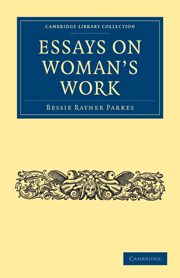IV - THE PROFESSION OF THE TEACHER
Published online by Cambridge University Press: 05 July 2011
Summary
IN casting a preliminary glance over the vast field of female paid labour in this country, a field which may be roughly calculated to embrace about three millions of women, or half its female population, I am well assured that one department will chiefly interest the majority of my readers—namely, the Profession of the Teacher. And this for an obvious reason, that it was until lately almost the only profession open to an educated woman of average ability. Few realise the extent to which women of the lower classes are employed in undomestic labour, in the factory, the workship, and the field;—but while all my lady readers have received instruction from some class of governess, there is probably not one who has not also some relative or cherished friend either actually engaged in teaching, or had formerly been so engaged. We find families who have no link with the army, the navy, or the church; others, who in all their wide-spread connexion have kept aloof from trade;—but from the highest to the lowest rank in which a liberal education is bestowed, we shall find some cousin or friend who is a governess. Indeed, it is not a question of rank at all, for the unmarried female members of the small merchant's family enter the profession from natural necessity, and the fortuneless daughters of the highly connected clergyman have often no other resource. It is a platform on which middle and upper classes meet,—the one struggling up, the other drifting down.
- Type
- Chapter
- Information
- Essays on Woman's Work , pp. 85 - 110Publisher: Cambridge University PressPrint publication year: 2010First published in: 1865



